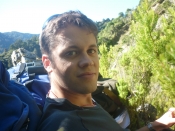Making it personal: Family history as a window into the past
Family history is my favourite type of history. Today I took my grandmother on a drive around Eastbourne, the seaside town she grew up in and left more than 60 years ago. I wanted the physical experience of being at a location to trigger her memories. Simply by driving around the town with a digital recorder attached to the sunshade I manage to capture her stories of anti-Japanese submarine booms being built, the excitement of receiving a flush toilet for the first time, seeing her friend’s foot attacked by a sand shark, the scandal of the house where the communists met and many more. For me the experience provided a perspective on the past that was deeply personal but that also raised many questions about the context of the time. It was the personal dimension of the drive that made me consider historical questions I may never have otherwise.
Recently I ran a family history project with a group of Year 9 students that also sought to engage students by starting with the personal: their families’ experiences of migration. The project was part of a broader unit on the history of multiculturalism in New Zealand. I thought it would be an interesting exercise to explore the origins of our country’s cultural diversity through an investigation of our families’ journeys.
Students were asked to talk to their parents and grandparents and to use various online databases for information. Earlier in the unit I had introduced them to the concept of historical causation by asking them to rank and categorize the causes of a racially motivated murder of a Chinese migrant in 1905. This task was designed to prepare them for how they needed to think when researching their family migration history. I wanted them to try and explain why their ancestors migrated to New Zealand. Some of the completed stories were published on the National Library of New Zealand’s Living Heritage site.
Students found it very difficult to transfer their learning about historical causation from the classroom context to their own family history inquiry. This resulted in many students chronicling their ancestors’ journey, rather than explaining why they migrated. There is also a significant risk that without an historical thinking approach family migration histories can become uncritical “celebration stories” (Sleeter). Many New Zealanders feel either pride or guilt about their family (or nation’s) history. These reactions to the past are different sides to the same coin, neither of which is particularly useful to develop evidence-based, contextualized knowledge of family history and its place within broader historical trends. I like family history for many reasons but perhaps most importantly because my ancestors were interesting, lived in an era different to my own and sometimes acted in ways that I find challenging but want to understand. I owe it to them to them move beyond a celebration story, and I owe it to my students to help them do the same. There is a lot more thinking to be done about using family history to develop students’ historical thinking. Like any good teaching inquiry, this project has raised many more questions than answers.
References:
Sleeter, C. (2008) ‘Critical Family History, Identity, and Historical Memory’ in Journal of the American Educational Studies association, 42, 2, pp.114-124.


